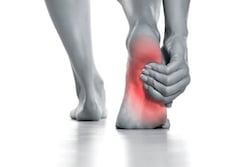
Researchers from Baskent University Medical School in Turkey conducted a randomized, prospective, double-blind clinical trial on different energy levels of Extracorporeal Shockwave Therapy (ESWT) and the impact on clinical outcomes for participants being treated for plantar fasciitis.
The intended purpose of the study was to explore the efficacy of ESWT and compare its different energy levels and outcomes in the treatment of plantar fasciitis
Insights abound in this comprehensive study and demonstrate the importance of this non-invasive modality revolutionizing regenerative care.
Common Plantar Fasciitis Treatment Protocols
Plantar fasciitis is a common and troubling foot condition that causes adult heel and arch pain. This condition is caused by inflammation of the plantar fascia, which connects the heel bone to the toes. he condition can cause excruciating pain and be particularly debilitating as it makes walking difficult and standing for extended periods next to impossible. Patients report that the worst pain occurs in the morning upon rising and stepping out of bed.
Upon diagnosis, treatment protocols are typically conservative and effective in nearly 90% of all cases and include:
- Physical therapy and stretching exercises
- Heel cups
- Orthotics and shoe modifications
- OTC nonsteroidal anti-inflammatory drugs
- Extracorporeal Shockwave Therapy (ESWT) (has been used for 20 years)
- Local corticosteroid injections
The efficacy of ESWT for plantar fasciitis has been clearly established in multiple clinical trials and meta-analyses.
Explore the valuable insights within this study, which examines ESWT energy levels, by reading it in its entirety. The study titled “Comparison of Plantar Pressure Distribution, Ultrasonographic and Clinical Features Following the Application of Different Energy Levels of Extracorporeal Shockwave Therapy in Patients with Plantar Fasciitis: A Randomized, Prospective, Double-Blind Clinical Trial” was conducted by Sukran Guzell, MD, Huma Boluk Selikci, MD, Hakan Suleyman Bal, MD and Bahtiyar Haberal, MD and published by The Journal of American Podiatric Medical Association, JAPMA 112 (4):e1-e26.
Materials and Methods of the Clinical Trial
In all, 51 participants involving 71 feet presented with heel pain and were diagnosed with plantar fasciitis between July and September of 2021. The diagnosis was made based on clinical presentations and evidence, including heel pain occurring in the first step upon rising or after rest and additional physical findings. An example of other symptomology includes pain on palpation of the site (plantar fascia insertion to the heel bone).
Patient participant inclusion criteria were as follows:
- Age 18-85
- Experiencing heel pain
- Tenderness at the insertion site
- Non-response to conservative treatment (over a period of 3 months)
Specific criteria constituted exclusion from the study:
- Inflammatory rheumatic disease
- Presence of local dermatological legion or infection
- Peripheral circulation conditions
- Radiculopathy and polyneuropathy
- Congenital or acquired foot deformity
- Malignancy
- Cardiac pacemaker
- Metal implants at the site location
- Pregnancy
Energy Levels and Shockwave Therapy for Plantar Fasciitis
Study participants were randomly divided into three treatment groups reliant upon the sealed envelope method.
- Group 1 – 25 feet treated with low energy density (0.09 mJ/mm2)
- Group 2 – 25 feet treated with medium energy density (0.18 mJ/mm2)
- Group 3 – 21 feet treated with high energy (0.38 mJ/mm2)
Shockwave was applied using a circular motion over the insertion site of the plantar fascia (1000 shocks) and along the fascia for 1000 shocks, receiving three sessions each with 2000 shocks per session at one-week intervals.
All participants within three groups (treated with low, medium, or high energy) were treated using a STORZ Medical radial pressure wave device. During the clinical trial, no participant received additional treatment interventions such as physical therapy, injections, or anti-inflammatory medications.
Pre- and post-treatment participants were evaluated using the following assessments:
- VAS (visual analog scale) for pain
- FFI (Foot Function Index)
- Plantar thickness (measured with ultrasonography and plantar pressure distribution)
ESWT/ Energy Levels – Results and Conclusions
Ultimately, among all participants in all three groups, post-treatment VAS and FFI were found to be statistically significantly lower than initial pretreatment values.
The study additionally concluded that neither of the levels (low, medium, high) of ESWT was found to be superior regarding pain, foot functions, fascia thickness, and pressure distributions while treating plantar fasciitis.
Patients suffering from acute or chronic plantar fasciitis or achilles tendonitis now have a fast non-invasive option to resolve there pain long term with Radial Shockwave!
